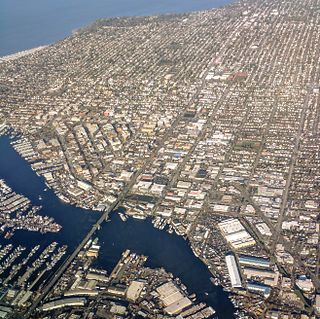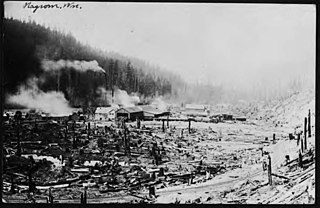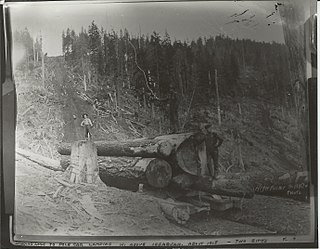
King County is located in the U.S. state of Washington. The population was 2,269,675 in the 2020 census, making it the most populous county in Washington, and the 13th-most populous in the United States. The county seat is Seattle, also the state's most populous city.

Snoqualmie is a city next to Snoqualmie Falls in King County, Washington, United States. It is 28 miles (45 km) east of Seattle. Snoqualmie city is home to the Northwest Railway Museum. The population was 10,670 at the 2010 census and an estimated 13,622 in 2019.

Klickitat is an unincorporated community and census-designated place (CDP) in Klickitat County, Washington, United States. The population was 362 at the 2010 census. Once the site of a lumber mill, it is now primarily a bedroom community.

Mukilteo is a city in Snohomish County, Washington, United States. It is located on the Puget Sound between Edmonds and Everett, approximately 25 miles (40 km) north of Seattle. The city had a population of 20,254 at the 2010 census and an estimated 2019 population of 21,441.

Ballard is a neighborhood in the northwestern area of Seattle, Washington, United States. Formerly an independent city, the City of Seattle's official boundaries define it as bounded to the north by Crown Hill, to the east by Greenwood, Phinney Ridge and Fremont, to the south by the Lake Washington Ship Canal, and to the west by Puget Sound's Shilshole Bay. Other neighborhood or district boundaries existed in the past; these are recognized by various Seattle City Departments, commercial or social organizations, and other Federal, State, and local government agencies.

The Great Seattle Fire was a fire that destroyed the entire central business district of Seattle, Washington on June 6, 1889. The conflagration lasted for less than a day, burning through the afternoon and into the night, and during the same summer as the Great Spokane Fire and the Great Ellensburg Fire. Seattle quickly rebuilt using brick buildings that sat 20 feet (6.1 m) above the original street level. Its population swelled during reconstruction, becoming the largest city in the newly admitted state of Washington.

Licton Springs or North College Park is a neighborhood in the informal Northgate district of North Seattle. It is bounded by Interstate 5 to the east, beyond which is Maple Leaf neighborhood and the Northgate Mall; Aurora Avenue N to the west, beyond which is Greenwood; N 85th Street to the south, beyond which is Green Lake, and N Northgate Way to the north, beyond which is Haller Lake.

Lester was a small town near Stampede Pass, just south of Snoqualmie Pass in King County, founded in 1892 by the Northern Pacific Railway. Lester is located along what is currently National Forest Development Road 54, on land owned by Tacoma Water, a division of Tacoma Public Utilities.
The Klickitat Trail is a 31-mile (50 km) rail trail along the Klickitat River in southern Washington in the Columbia River Gorge. The cycling and hiking trail offers river and canyon views throughout its length. It follows an old railroad corridor that at one time linked the towns of Lyle and Goldendale.

The East Kong Yick Building is one of two buildings erected in Seattle, Washington's Chinatown-International District (ID) by the Kong Yick Investment Company. A four-story hotel in the core of the ID, with retail stores at ground level, the East Kong Yick was created by the pooled resources of 170 Chinese American pioneers. In, 2008, the building reopened as the home of the expanded Wing Luke Asian Museum.
Dee is an unincorporated community and former company town in Hood River County, Oregon, United States, on Oregon Route 281, about 11 miles south of Hood River.

Nagrom was a town in King County, Washington, United States.

Monohon was a town located on the east side of Lake Sammamish, near the present-day intersection of East Lake Sammamish Parkway and SE 33rd Street in the city of Sammamish. The community was originally part of a town named Donnelly, founded by Simon Donelly who built a sawmill there, but then grew big enough and was far enough away from Donelly that residents created a separate town, Monohon, in 1888. The new town was named after Martin Monohon who had homesteaded 160 acres (0.65 km2) there in 1877. The railroad along the east side of the lake was completed in 1889, and the Donnelly mill was moved to the site of Monohon.
Korbel is an unincorporated community in Humboldt County, California. It is located 1.5 miles (2.4 km) east-southeast of Blue Lake, at an elevation of 154 feet. The ZIP Code is 95550.

Barneston is an extinct town in King County, in the U.S. state of Washington. The GNIS classifies it as a populated place.

High Point is an unincorporated community in King County, in the U.S. state of Washington.
Kerriston is an extinct town in King County, in the U.S. state of Washington. The GNIS classifies it as a populated place.
Lavender is an unincorporated community in Kittitas County, in the U.S. state of Washington.
Page is an extinct town in King County, in the U.S. state of Washington. The GNIS classifies it as a populated place.
Taylor is an extinct town in King County, in the U.S. state of Washington.















